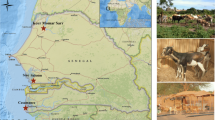Abstract
Ticks of the genus Dermacentor are important vectors of human and animal pathogens in North America. They also carry a variety of endosymbiotic (i.e. non-pathogenic) bacteria. The American dog tick, D. variabilis, is known to be infected with gammaproteobacteria of the genus Arsenophonus. However, there have been no previous reports of Arsenophonus-type bacteria in the Rocky Mountain wood tick, D. andersoni, a species that is sympatric with D. variabilis in the western parts of its distributional range. In this study, the presence of Arsenophonus-type bacteria was determined by PCR and DNA sequencing for 338 D. andersoni and 448 D. variabilis adults from western Canada. Fifty-one (15%) of the D. andersoni were found to be infected with Arsenophonus, whereas only a single D. variabilis was infected. The prevalence of Arsenophonus in D. andersoni varied among localities (0–27%). The 16S rDNA sequences of Arsenophonus in Canadian D. andersoni and D. variabilis were identical to one another, but the results of a phylogenetic analysis showed that they were genetically distinct from, and may represent a different species to, the Arsenophonus in D. variabilis and Amblyomma americanum in eastern USA.

Similar content being viewed by others
References
Balas MT, Lee MH, Werren JH (1996) Distribution and fitness effects of the son-killer bacterium in Nasonia. Evol Ecol 10:593–607
Clay K, Klyachko O, Grindle N, Civitello D, Oleske D, Fuqua C (2008) Microbial communities and interactions in the lone star tick, Amblyomma americanum. Mol Ecol 17:4371–4381
Dale C, Beeton M, Harbison C, Jones T, Pontes M (2006) Isolation, pure culture, and characterization of “Candidatus Arsenophonus arthropodicus”, an intracellular secondary endosymbiont from the hippoboscid louse fly Pseudolynchia canariensis. Appl Environ Microbiol 72:2997–3004
Dergousoff SJ, Chilton NB (2007) Differentiation of three species of ixodid tick, Dermacentor andersoni, D. variabilis and D. albipictus, by PCR-based approaches using markers in ribosomal DNA. Mol Cell Probes 21:343–348
Dergousoff SJ, Gajadhar AJA, Chilton NB (2009) Prevalence of Rickettsia in Canadian populations of the ticks Dermacentor andersoni and D. variabilis. Appl Environ Microbiol 75:1786–1789
Dodds DG, Martell AM, Yescott RE (1969) Ecology of the American dog tick, Dermacentor variabilis (Say), in Nova Scotia. Can J Zool 47:171–181
Duron O, Bouchon D, Boutin S, Bellamy L, Zhou L, Engelstadter J, Hurst G (2008) The diversity of reproductive parasites among arthropods: Wolbachia do not walk alone. BMC Biol 6:27
Gregson JD (1956) The Ixodoidea of Canada. Canada Department of Agriculture, Ottawa
Grindle N, Tyner JJ, Clay K, Fuqua C (2003) Identification of Arsenophonus-type bacteria from the dog tick Dermacentor variabilis. J Invertebr Pathol 83:264–266
Hypša V, Dale C (1997) In vitro culture and phylogenetic analysis of “Candidatus Arsenophonus triatominarum”, an intracellular bacterium from the triatomine bug, Triatoma infestans. Int J Syst Bacteriol 47:1140–1144
Merten HA, Durden LA (2000) A state-by-state survey of ticks recorded from humans in the United States. J Vector Ecol 25:102–113
Mollet C, Drancourt M, Raoult D (1997) rpoB sequence analysis as a novel basis for bacterial identification. Mol Microbiol 26:1005–1011
Skinner SW (1985) Son-killer: A third extrachromasomal factor affecting the sex ratio in the parasitoid wasp, Nasonia (Mormoniella) vitripennis. Genetics 109:745–759
Sonenshine DE (1979) Zoogeography of the American dog tick, Dermacentor variabilis. In: Rodriguez JG (ed) Recent Advances in Acarology, volume II. Academic Press, New York, pp 123–134
Šorfová P, Škeříková A, Hypša V (2008) An effect of 16S rRNA intercistronic variability on coevolutionary analysis in symbiotic bacteria: molecular phylogeny of Arsenophonus triatominarum. Syst Appl Microbiol 31:88–100
Swofford DL (2003) PAUP*: Phylogenetic analysis using parsimony (*and other methods) version 4. Sinauer Associates, Sunderland
Thao ML, Baumann P (2004) Evidence for multiple acquisition of Arsenophonus by whitefly species (Sternorrhyncha:Aleyrodidae). Curr Microbiol 48:140–144
Trowbridge RE, Dittmar K, Whiting MF (2006) Identification and phylogenetic analysis of Arsenophonus- and Photorhabdus-type bacteria from adult Hippoboscidae and Streblidae (Hippoboscoidea). J Invertebr Pathol 91:64–68
Acknowledgments
Funding for this work was provided to NBC from the Natural Sciences and Engineering Research Council of Canada (NSERC) and the Canadian Foundation for Innovation. SJD received funding through a NSERC Postgraduate Scholarship. We thank John Allen, Alvin Gajadhar, Murray Lankester, Brad Scandrett, and Travis Quirk, who provided some ticks, and Lorilee Flavelle and Andrew Gajadhar for technical assistance.
Author information
Authors and Affiliations
Corresponding author
Rights and permissions
About this article
Cite this article
Dergousoff, S.J., Chilton, N.B. Detection of a new Arsenophonus-type bacterium in Canadian populations of the Rocky Mountain wood tick, Dermacentor andersoni . Exp Appl Acarol 52, 85–91 (2010). https://doi.org/10.1007/s10493-010-9340-5
Received:
Accepted:
Published:
Issue Date:
DOI: https://doi.org/10.1007/s10493-010-9340-5




